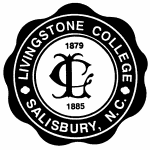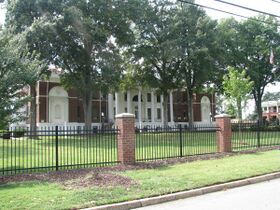Organization:Livingstone College
 Livingstone College Seal | |
Former name | Zion Wesley Institute (1879–1887) |
|---|---|
| Motto | A Call To Commitment. Taking Livingstone College to the next level |
| Type | Private historically black college |
| Established | 1879 |
Religious affiliation | African Methodist Episcopal Zion Church |
| President | Anthony Davis |
Academic staff | 59 (fall 2021)[1] |
| Students | 890 (fall 2021)[1] |
| Location | Salisbury , North Carolina , U.S. |
| Campus | Small town, 272 acres (1.10 km2) |
| |u}}rs | Columbia blue and black |
| Nickname | Blue Bears |
| Mascot | Blue Bear |
| Website | www |
Livingstone College Historic District | |
 Livingstone College, September 2012 | |
| Lua error in Module:Location_map at line 522: Unable to find the specified location map definition: "Module:Location map/data/North Carolina" does not exist. | |
| Location | W. Monroe St., Salisbury, North Carolina |
| Coordinates | [ ⚑ ] : 35°40′14″N 80°28′59″W / 35.67056°N 80.48306°W |
| Area | 23 acres (9.3 ha) |
| Built | 1882 |
| Architectural style | Victorian Eclectic |
| NRHP reference # | 82003509[2] |
| Added to NRHP | May 27, 1982 |
Livingstone College is a private historically black Christian college in Salisbury, North Carolina. It is affiliated with the African Methodist Episcopal Zion Church. Livingstone College is accredited by the Southern Association of Colleges and Schools to award bachelor's degrees.
History
Livingstone College along with Hood Theological Seminary began as Zion Wesley Institute in Concord, North Carolina in 1879. After fundraising by Joseph C. Price and J. W. Hood, the school was closed in Concord and reopened in 1882 a few miles north in Salisbury.[3]
Zion Wesley Institute was founded by the African Methodist Episcopal (AME) Zion Church. The institute changed its name to Livingstone College in 1887 to honor African missionary David Livingstone. That same year, the school granted its first degree.[4] The first group of students to graduate included eight men and two women, the first black women to earn bachelor's degrees in North Carolina.[5]
Originally beginning with 40 acres on a Salisbury farm called Delta Grove,[3] Livingstone College's main campus now consists of 272 acres.[6]
In August 2014, Livingstone submitted plans for converting a former Holiday Inn on Jake Alexander Boulevard into a hospitality school.[7] Livingstone's School of Hospitality Management & Culinary Arts, a program accredited in 2012, had moved to the new location by 2015.[8][9]
Livingstone College Historic District
The Livingstone College Historic District is a national historic district listed on the National Register of Historic Places in 1982.[2] The district encompasses 16 contributing buildings, 1 contributing structure, and 1 contributing object on the Livingstone College campus and adjacent residential sections in Salisbury. Notable buildings include the Price house (1884), Harris house (1889), Aggrey house (1912), Ballard Hall (1887), Dodge Hall (1886), Carnegie Library (1908), Goler Hall (1917), Hood Building (1910), and Price Memorial Building (1930-1943).[10]
Athletics
On the campus is an athletic marker erected in 1956 to commemorate the first African-American intercollegiate football game, in 1892.[10]
Livingstone is a member of the National Collegiate Athletic Association (NCAA), Division II, and the Central Intercollegiate Athletic Association (CIAA). Its intercollegiate sports programs include basketball, bowling, cross-country, football, softball, volleyball, tennis, golf, and track and field. The nickname for the school's teams is the Blue Bears.
The Livingstone College football team has had a long history since playing in the first Black college football game in 1892 against Johnson C. Smith University (then called Biddle University).[11] The rivalry between the two schools continues to this day as the Commemorative Classic. The Blue Bears also maintain a rivalry with their cross town rival Catawba College Indians. The early October game between the two schools is called the Mayors' Cup.
The current football stadium that the university uses for matches is the Alumni Memorial Stadium (Livingstone)
Notable alumni
| Name | Class year | Notability | Reference(s) |
|---|---|---|---|
| Charles Sterling Acolatse | Ghana jurist, Supreme Court Judge of Ghana | ||
| Bernard E. Anderson | Whitney M. Young, Jr. Professor Emeritus at the Wharton School of the University of Pennsylvania,[12] where he was the first African American tenured professor[13] was Assistant Secretary of Labor during the Clinton Administration, and is a member of the Board of Trustees of Tuskegee University[12][14][15] | ||
| Daniel S. Bentley | minister, writer, and African American newspaper proprietor | [16] | |
| Roy Davage Hudson | B.S. 1955 | neuropharmacologist and former president of Hampton University | [17][18] |
| William J. Trent | 1930 | Executive Director of the United Negro College Fund | https://www.nytimes.com/1993/11/29/obituaries/william-trent-83-director-of-negro-college-fund.html |
| Ruth Whitehead Whaley | First Black woman admitted to the bar in New York and North Carolina. | ||
| Drew Powell | 2015 | Indoor Football League quarterback for the Arizona Rattlers |
Notable faculty
| Name | Department | Notability | Reference |
|---|---|---|---|
| George James | Professor | was a South American historian and author, best known for his 1954 book Stolen Legacy, in which he argued that Greek philosophy originated in ancient Egypt. |
References
- ↑ 1.0 1.1 "College Navigator - Livingstone College". https://nces.ed.gov/collegenavigator/?s=NC&pg=6&id=198862.
- ↑ 2.0 2.1 "National Register Information System – (#82003509)". National Register of Historic Places. National Park Service. July 9, 2010. https://npgallery.nps.gov/AssetDetail/NRIS/82003509.
- ↑ 3.0 3.1 "About Livingstone". Livingstone College. http://livingstone.edu/about-livingstone/.
- ↑ Franz, Alyssa (11 March 2010). "Livingstone College (1879-- )". Online Encyclopedia of Significant People and Places in African American History. BlackPast.org. http://www.blackpast.org/?q=aah/livingstone-college-1879. Retrieved May 4, 2012.
- ↑ Gilmore, Glenda Elizabeth (1996). Gender and Jim Crow: Women and the Politics of White Supremacy in North Carolina, 1896-1920. Chapel Hill: The University of North Carolina Press. p. 40. ISBN 978-0807845967. https://archive.org/details/genderjimcrowwom0000gilm.
- ↑ Campbell, Sarah (February 14, 2011). "Livingstone College has history of producing leaders". The Salisbury Post. http://www.salisburypost.com/article/20110307/SP0101/303079999/0/SEARCH&slId=5.
- ↑ "City approves new Holiday Inn, Livingstone buying old hotel". The Salisbury Post. August 20, 2014. https://www.salisburypost.com/2014/08/20/city-approves-new-holiday-inn-livingstone-buying-old-hotel/.
- ↑ Groh, Jeanie (January 3, 2015). The Salisbury Post. https://www.salisburypost.com/2015/01/03/10-to-watch-vivian-ray/title=City approves new Holiday Inn, Livingstone buying old hotel.
- ↑ Willis, Laurie D. (October 8, 2015). "Livingstone hosts fundraiser for Heritage Hall renovation". The Salisbury Post. https://www.salisburypost.com/2015/10/08/livingstone-hosts-fundraiser-for-heritage-hall-renovation/.
- ↑ 10.0 10.1 Dave Brown (June 1980). "Livingstone College Historic District". National Register of Historic Places - Nomination and Inventory. North Carolina State Historic Preservation Office. https://files.nc.gov/ncdcr/nr/RW0013.pdf.
- ↑ Greenlee, Craig T. (June 17, 2007). "Small schools - Where Football Is An Activity, Not a Business". Diverse Issues in Higher Education. http://diverseeducation.com/article/7547/.
- ↑ 12.0 12.1 "Bernard Anderson | Tuskegee University". https://www.tuskegee.edu/about-us/board-of-trustees/bernard-anderson.
- ↑ "CSMGEP Profiles: Bernard E. Anderson, University of Pennsylvania". https://www.aeaweb.org/about-aea/committees/csmgep/profiles/bernard-anderson.
- ↑ Admin, E. S. I. (2016-11-08). "ESI Senior Advisor Bernard Anderson To Recieve [sic UAC Living Legacy Award"] (in en-US). https://econsultsolutions.com/esi-senior-advisor-bernard-anderson-to-recieve-uac-living-legacy-award/.
- ↑ "Award Recipients 2022". https://www.leraweb.org/award-recipients-2022.
- ↑ Smith, Gerald L.; McDaniel, Karen Cotton; Hardin, John A. (2015-08-28) (in en). The Kentucky African American Encyclopedia. University Press of Kentucky. pp. 41. ISBN 978-0-8131-6066-5. https://books.google.com/books?id=-0AoCgAAQBAJ.
- ↑ Ploski, Harry A.; Williams, James De Bois (1990) (in en). Reference Library of Black America. Gale Research Incorporated. pp. 1410. https://books.google.com/books?id=8w0vAAAAMAAJ.
- ↑ Henderson, Ashyia N. (2000) (in en). Who's Who Among African Americans. Gale Group. pp. 647. ISBN 978-0-7876-3634-0. https://books.google.com/books?id=jAww_OufVCEC.
External links
 |
